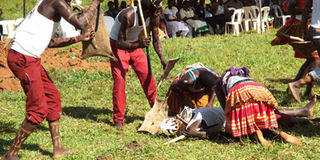Lango men forced to ‘marry’ the dead

Arts. Students of Agweng Secondary School in Lira District perform a cultural dance showing how women mourn their dead husbands. PHOTO BY ISAAC OTWII
What you need to know:
- Last month, James Odongo was asked to pay nine cows, eight goats and Shs15m as compensation to his deceased partner’s relatives.
- The Lango are Nilotic ethnic group of northern Uganda. According to their oral traditions, they originated from Abyssinia present day Ethiopia.
LIRA. Having found affection for each other, Agnes Aceng of Kirombe North A Village, Adyel Division in Lira Municipality, and her partner James Odongo opted for cohabitation.
But their bond was short-lived with Aceng passing on just after a fortnight of bliss.
The 28-year-old reportedly developed pain in her lower abdomen on November 23 and died the following day.
Odongo was consequently arrested and detained at Lira Central Police Station.
Later, a post-mortem examination conducted at Lira regional referral hospital indicated Aceng had died due to ectopic pregnancy.
An ectopic pregnancy occurs when a fertilised egg implants itself outside the womb, usually in one of the fallopian tubes.
This means the embryo will not be able to develop into a baby as the fallopian tube is not large enough to support its growth.
Following the incident, the man’s Okarowok clan and the deceased’s Pedi-Ogu-gwang clan members agreed to submit to Lango’s traditional justice system of compensating the family of the dead woman.
After a day’s deliberations and negotiations, Mr Odongo was made to pay nine cows, eight goats and Shs15m as compensation to the deceased’s relatives.
Requirements
Dr Richard Nam, the prime minister of Lango Cultural Foundation, explains that a man is required to pay half of what he could have paid as bride price in an actual marriage.
Mr Nicholas Ogwang, the Uganda Human Rights Commission (UHRC) regional manager, says the Commission has started an awareness campaign to educate cultural leaders on the aspects surrounding culture.
He says forcing a man to pay a fine to the family of the dead woman he was cohabiting with is inconsistent with human rights law.
Ms Barbra Akech, an Alebtong District LC5 councillor, says the practice is disrespectful to women.
But Mr Samuel Akome, a bicycle repairer in Lira Town, defends the cultural aspect, saying it is the only way clans can weed out cohabitation. “When someone is aware that he will have to marry the dead body of a woman, he will start with initiating marriage processes before taking the woman to his home. With that we shall have avoided cohabitation in our communities,” he says.
According to Mr David Livingstone Okwir, 80, the practice is a cultural norm that the people of Lango subscribe to and no one can debate it.
“People used to pay blood for blood, meaning when the woman died at your home, the other clan shall have to revenge by killing,” he explains.
“If the norm of marrying the dead was not there, we would be killing each other by paying blood for blood.” The former deputy Inspector General of Police, Mr Julius Peter Odwee, who is also the clan chief of Okii-Ogwangkol, agrees the culture is treated as blood compensation among the Langi.
“The man’s clan is subjected to pay the requisite before burying the woman’s body and if he doesn’t pay, the woman’s clan will take the body and bury it but still the man will have to pay,” he says.
The practice is common among the Lango, Kumam, Iteso, Acholi and Karimojong.
The law
No protection. Cohabitation in Uganda does not give one legal protection after a break-up.
Women rights’ activists have for a long time advocated legalisation of cohabitation through fronting the Marriage and Divorce Bill although they have not been successful.
They reason that women should be recognised for their contribution towards the wellbeing of the marriage during that time. But men think women are after their property.
Only marriages in church, mosques, marriages presided over by the Administrator General and customary marriage are recognised legally.
About the sub-region
Coverage. Lango Sub-region covers the area that was initially known as Lango District until 1974, when it was split into the districts of Apac and Lira, and subsequently into several other districts including Dokolo, Otuke, Alebtong, Apac, Amolatar, Kole, Oyam, Lira, and Kwania. The sub-region is home mainly to the Lango ethnic group. According to the National Population and Housing Census of 2014, the eight districts of Lango Sub-region had a total population of 2.1 million people. The Lango symbol is the Rhino.
Background
Origin. The Lango are Nilotic ethnic group of northern Uganda. According to their oral traditions, they originated from Abyssinia present day Ethiopia.
In his book “The Tricenerary of Lango people in Uganda”, Julius Peter Odwee, traces the migration of the Lango tribe right through Otuke hills and mentions several similarities between Lango culture and their Ateker neighbours.
He asserts that the people of Lango acquired adopted a mixture of the Luo-Nilotic dialect as a language due to intermarriage between the Lango and the Luo speaking neighbours. This he asserts happened prior to their migration into present day Uganda.




